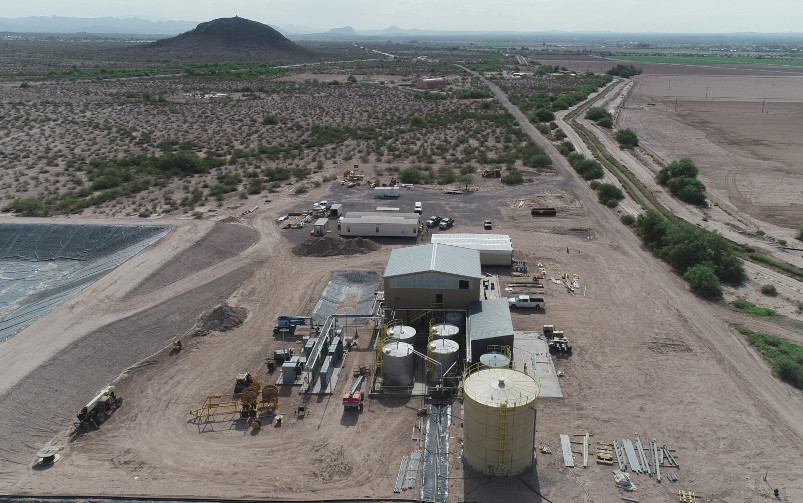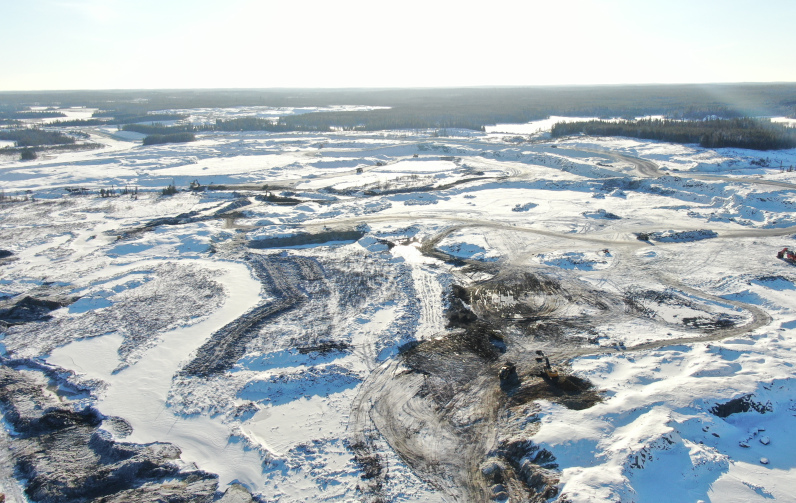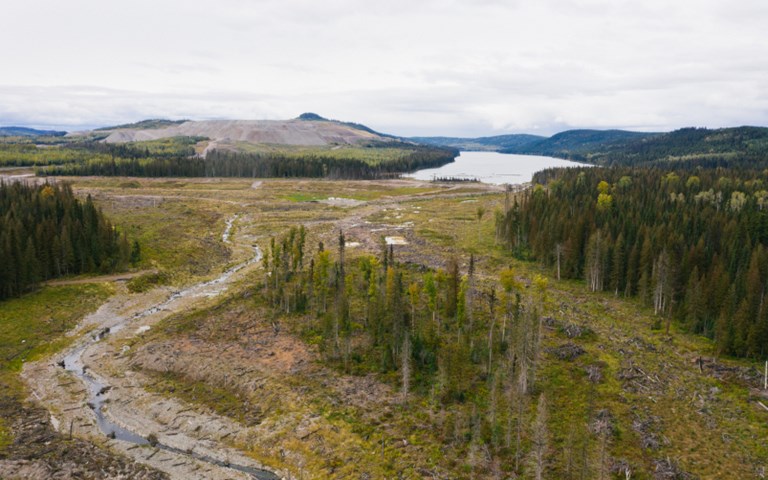Remediation work around the Mount Polley mine following the 2014 tailings dam breach, including on the Hazeltine Creek (bottom left), was completed in the spring and environmental monitoring continues. Courtesy of Imperial Metals
In June 2022, Imperial Metals put ore through its Mount Polley mill to process it into copper concentrate for the first time since the company shut down the mine in May 2019, due to sagging copper prices.
When the company put the British Columbia operation into care and maintenance, it did so with an eye to a future restart. That meant that while the trucks were parked, the mill was turned over at regular intervals to prevent the bearings from developing flat spots and to keep the balls free.
Restarting the mill has meant repairing and refurbishing the grinding and processing circuit and essentially returning it to “zero-hour point,” said Brian Kyoch, Imperial Metals president.
One change, however, that Imperial has made is to the way the Mount Polley flotation circuit operates. Kyoch said that the mine’s Springer pit has been mined down through the oxide cap, and that the remaining deposit is sulfide ore. “There’s part of the flotation circuit, we call our oxide circuit, that we’re not reconditioning because we’re not planning to use it when we first start,” said Kyoch.
Restart costs, calculated from March 2021 until March 2022, were listed as $22.4 million in the company’s Q1 report. “For the March 2022 quarter, Mount Polley incurred restart costs comprising $21.7 million in operating costs and $0.7 million in depreciation expense," the company reported.
Kyoch said that finding and hiring qualified employees is an ongoing challenge, despite the mine site being located so that workers can return home after their shifts. Imperial’s intention is to eventually get back to the same employment figures as before the shutdown (between 300 and 350).
Imperial has rehired workers let go in 2019 and has members of the Xatśūll First Nation and the Williams Lake First Nation (T’exelcemc) employed at the site. Kyoch said that Imperial has long-standing (since 2012) community investment agreements with both First Nations, and that on April 12, the company signed a revised version with Williams Lake. Talks are ongoing with the Xatśūll to reach a similar arrangement.
William Lake First Nations Chief Willie Sellars said that employment opportunities exist at the mine for members of the Nation.
“Anybody who wants a job at the mine site, will get a job as long as they pass preliminary employment qualifications or pass a drug test. We have a main line for career jobs at the mine site, which is great. We’re also going to put together a revenue stream and bring capacity funding to help subsidize the internal work of our staff and leadership. So yeah, the relationship is good. It’s awesome. And we’re stoked to be standing alongside them on the reopening of this mine,” said Chief Sellars, though his enthusiasm is tempered with caution. “We know the importance of what a mine like that can do for opportunities for membership, to provide for their families, what it’ll do to the local economy here in Williams Lake. But we also understand the importance of making sure that we have a seat at the table: that we’re getting constant feedback and providing comments and input on mine operations, and just being cognizant of the impacts to the environment. Being stewards of the land, we have to make sure that we are being heard with those concerns.”
The mine is currently operating under a nine-year end-of-life plan. While Kyoch has been primarily concerned with the restart process, the company is likely going to add a lift to the existing tailings storage facility (TSF) this summer and that future exploration is already being considered. Both the C2 zone, located south of the Caribou pit, and the WX zone, which is south of the Springer pit, hold potential, but WX will be first up, since it is between two mineralized zones. Kyoch noted that if WX is turned into a mine, “the majority of the revenue is likely to be from gold.”
According to a March 2021 report, Mount Polley’s proven and probable reserves are 400 million pounds of copper, 517,000 gold ounces and 1.5 million silver ounces from 53 million tonnes. The grades are 0.34 per cent copper, 0.3 gold and 0.9 silver. In 2018 the mine produced 14.9 million pounds of copper and 37,120 ounces of gold.
Of course expanding or even restarting the mine is always going to be a corporate communications challenge, as the Mount Polley name has been inextricably linked with the tailings dam breach that occurred in August 2014, which released “17 million cubic metres of water and eight million cubic metres of tailings/materials into Polley Lake, Hazeltine Creek and Quesnel Lake,” according to the Government of British Columbia.
According to Kyoch, all the physical work has been completed to restore Hazeltine Creek, and fish have returned to the water, but he acknowledges that Imperial still must earn trust back with the public.
“We have focused on earning the trust back of the locals – the people who can go see what we’ve done, and be part of it… It was not easy after the breach to get going again, like we did in 2015, and then get going again now. It’s hard work,” he said.
It does, however, seem to be work that is paying off.
Aaron Higginbottom, senior manager, natural resources and economic development for Williams Lake First Nation, said that he has been happy with the way both Imperial responded to the breach and to how the local area is responding to the company’s remediation efforts.
“It’s going to take a long time… If you jump in there and you’re reactive, you can bring back a lot of habitat within about 12 years and have the original water-carrying capacities back in the area,” he said, noting that the recovery is still ongoing. “It’s going to take a while. We’re about six years in, so in another six years, I think it’s going to be a lot healthier. It takes time. It’s to be expected.”




